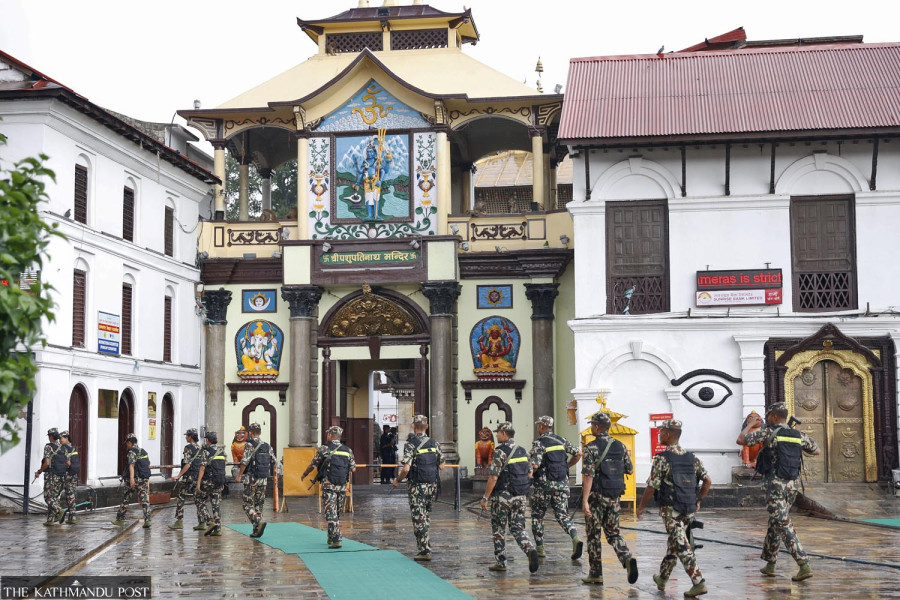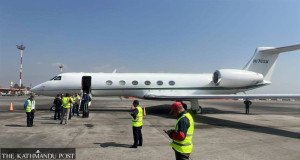National
Do laws and institutions to preserve Nepal’s ancient monuments work?
Department of Archaeology, responsible for preventing breach of the law, is toothless. Observers say only by making it strong and independent can monuments be saved.
Anup Ojha
Last week, ‘Jalahari’, the golden receptacle that covers the base of the Shiva Linga and collects and drains liquids like water and milk offered to Lord Shiva at the Pashupatinath Temple, made headlines after the Commission for the Investigation of Abuse of Authority (CIAA) took it off from the main temple to measure its weight. The golden receptacle had been installed in the third week of February in 2021.
Although the CIAA didn’t find any significant difference in the weight of the gold used in the Jalahari installed in the precincts of the Pashupatinath Temple, the issue sparked a debate as the Pashupati Area Development Trust (PADT) was found to have flouted due process.
According to CIAA officials, the gold in the Jalahari was measured at 107.46kg, which is close to its weight stated earlier—107.92kg.
Last year, amid severe criticism from local residents, heritage conservationists and priests, the PADT went ahead with its plans to replace the temple’s silver Jalahari with a golden one. Oddly, the then President Bidya Devi Bhandari installed a 96.822kg golden structure just hours before a Supreme Court stay order.
The apex court issued the order after hearing a petition filed by the former treasurer of the Trust, Narottam Baidya, and lawyer Nikita Dhungana who had challenged the government’s decision to install the golden Jalahari.
The writ petitioners had claimed that replacing the silver Jalahari with a golden one was against the Ancient Monument Preservation Act-1956.
Section 12 of the Act says that one who destroys, demolishes, removes, alters, defaces or steals an ancient monument or archaeological object is subject to punishment with a fine of Rs25,000 to Rs 100,000 or with an imprisonment of 5 years to 15 years or both, after recovering an amount equal to the claimed amount for the damage to the object concerned.
The Act has been limited to the paper, Baidya said. “If only the government authorities had followed the Act, they would not have installed the golden Jalahari,” he added.
Although the Ancient Monument Preservation Act-1956 is crucial to preserving the ancient monuments that have historical and archeological value, whether it is actually being implemented is a different matter altogether.
“The local, provincial and federal levels should strictly follow the Act, and the Department of Archaeology (DoA) should ensure that they are doing so,” said Baidya. “But in most cases, the department takes little or no action.”
Why the Act?
The Act says any ‘ancient monuments’, historical buildings and heritage sites such as temples, houses, abbey, cupola, monastery, stupa, bihar, etc., which are older than one hundred years are important from the view of history, arts, science, architecture or art of masonry and need to be preserved in their original form. Any modification in the object, if necessary, requires authorisation from the Department of Archaeology.
The Act states that if any of the monuments needs conservation, maintenance and renovation, it can be carried out by the Guthi Sansthan under supervision, technical service and direction of the department. The Section 13(2) says that if a person or an institution possesses traditional, ancestral or archeological objects that are over one hundred years old, the owner of such collections shall have to register such items in a prescribed office.
“The main purpose of establishing the Act is to preserve ancient monuments and heritage in their original form, but the problem is that even the officials including the Head of State seem unaware of the importance of our heritage,” said Bhim Nepal, a monument conservationist.
Who owns the monuments?
In relation to ownership, ancient monuments are classified under two categories: public ancient monuments and private ancient monuments. In terms of their importance, these monuments come under three categories—the ones having international importance, national importance and local importance.
The Pashupatinath Temple covers all three categories. And, as it is listed among the UNESCO World Heritage Sites, it holds great historical, cultural and religious significance and it has both artistic as well as archeological values.
According to Section 3 (B) of the Act, it’s the Department of Archeology that owns them and it shall conserve, maintain and renovate public ancient monuments.
Meanwhile, the conservation, maintenance and renovation of monuments under private ownership, and which are inside the protected monuments area, shall be carried out by the concerned person. If such monuments need to be repaired, or touched, the person should take permission from the DoA.
How active is the department?
Although the Act gives the DoA authority to look after ancient monuments, it has not been able to do its job effectively. “The Act was formulated in good faith but the DoA has not been able to function as desired to make it effective,” said Ganapati Lal Shrestha, a heritage conservation activist.
Meanwhile, Prakash Mani Sharma, a senior advocate who has long been advocating for the preservation of cultural and natural heritage, says the main problem of the department is that it’s a unit that works under the Ministry of Culture, Tourism and Civil Aviation.
“For its greater effectiveness, the DoA should be an independent high-powered autonomous authority as in India,” said Sharma.
He also expressed concern at the state of seven out of the 10 UNESCO World Heritage Sites in Nepal in the Kathmandu Valley: Durbar squares of Kathmandu, Bhaktapur and Lalitpur, Swayambhunath, Bauddhanath, Pashupatinath and Changunarayan.
“It’s high time the department was given more independence,” said Sharma.
Shrestha, the conservationist, said that the district administration and local units are not serious about preserving heritage sites. “In cases of breach of archeological values, the role of the department of archaeology is limited to just dispatching a letter,” he added.
Shrestha said unless the DoA has its own police or security force that can intervene when someone breaches the archaeological value of the historical sites, it can’t effectively preserve any monuments or structures. He said the chief district officer and the local authority should work with the DoA to preserve monuments.
Protection of the shrines and temples
Conservationists say the issue of protection and conservation of heritage drew public attention mainly after the 2015 earthquakes when a large number of heritage sites were destroyed or damaged. According to the department, a total of 745 historical, cultural and religious monuments in 20 districts were damaged in the disasters.
“But the local authority and the Kathmandu Valley Development Authority have never coordinated with DoA for the protection and preservation of heritage sites,” said Shrestha.
The Ancient Monument Preservation Act-1956 doesn’t allow construction of underground structures near heritage sites, but the Kathmandu Metropolitan City has been giving permissions for such underground construction.
“Unless the local, provincial, and federal governments are serious about the Act’s implementation and are ready to follow the DoA’s instructions, it will be impossible to protect shrines and temples with historical and archeological importance,” said Shrestha.
Breaches of the Act
Over time, there have been many breaches of the Act, and the PADT and Kathmandu Metropolitan City (KMC) are among the main violators. For example, apart from the Jalahari issue, the Trust had back in February 2019 used ‘concrete’ to erect pillars and fill 12 dug pits in the unique Vishwaroop temple in the premises of Pashupati. But it backtracked after public criticism. Six months prior to the controversy, the Trust had come under fire after it used plain cement concrete—a binding agent in construction materials—to build the 170-metre pavement in the Mrigasthali area that led to the temple.
In December 2017, too, the Trust was widely criticised for using concrete in the reconstruction of historic Bageshwori Temple in Pashupati. And, just five months ago, the Trust demolished one of the four Shivalayas in the temple premises, upsetting many religious and cultural activists.
Similarly, the KMC was criticised for using concrete at the historical Rani Pokhari in 2017 and Kamal Pokhari in 2021, and had invited controversy for erecting concrete structures at the Kathmandu Durbar Square, another UNESCO World Heritage Site, without consulting the DoA.
“The then prime Minister KP Sharma Oli announced, with great fanfare, the construction of a new Dharahara in 2016, but he ended up making a concrete pillar. This was not in keeping with the norms of heritage conservation,” said Nepal, the monument conservationist.
“If he was interested in conservation, he could have rebuilt it using original material. This shows the level of understanding of the value of heritage and their conservation among senior politicians and bureaucrats. Unless they understand the value of such tangible and intangible heritage, the Act alone can’t work.”
Should the Act be amended?
“Even though the Act was formulated six decades ago, the law was made with great foresight for the preservation of heritage sites,” said advocate Sharma.
He said one immediate amendment that needs to be made in the Act is that it only talks about preserving tangible heritages such as physical artefacts and their original structures. “But it is silent on intangible heritages such as Jatras [festivals], Parba, ancient knowledge, wisdom, skills, hymns, and mantras,” Sharma added.




 21.12°C Kathmandu
21.12°C Kathmandu.jpg)















